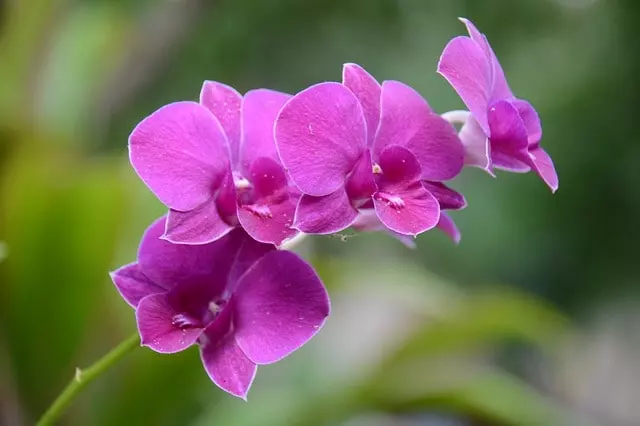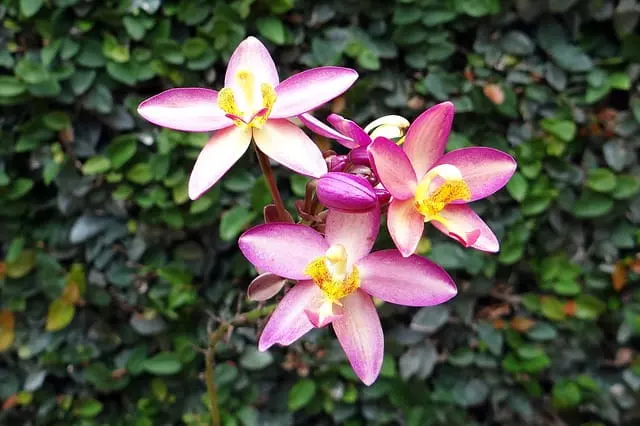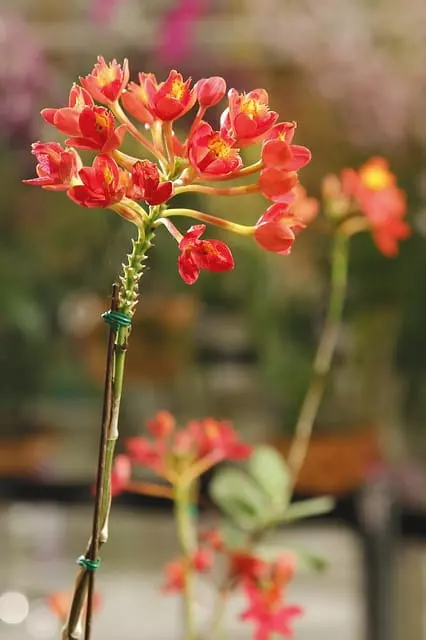In this article, we will talk about terrestrial orchids. We will start with the definition and characteristics of this type of orchid, to continue with their habitat and origin.
We will finish with the basic care that you should give to orchids of this type.
Table of Contents
Characteristics Of Terrestrial Orchids
Terrestrial orchids, or ground orchids, are orchids that grow in the ground because their roots grow below the soil, and therefore their stems are usually more upright. In this way, they obtain the nutrients and water they need directly from the soil.
In addition, due to its development in the soil, it develops tubers from which the plant itself feeds. Sometimes the tubers change color from white to black, indicating that the plant has been well-nourished throughout the year.
A unique feature of this flower is its ability to bloom for an extended period if growing conditions are optimal. It blooms in all seasons. This type of orchid is available in white, peach, pink, purple, yellow, and magenta colors.
Types Of Terrestrial Orchids
These flowers are of two types, Chinese (Bletilla hyacinthine) and Malayan (Spathoglottis plicata). The latter species is more popular in the floral industry, mainly because of its cold-resistant nature and long flowering period.
These types of orchids grow in any type of soil and environment, however, they occur more in temperate zones. For this reason, they are a favorite for people to have in their homes, as they adapt easily to any type of soil.
As there are so many varieties of terrestrial orchids, here we will point out which are the showiest and sought after to have. Among those that stand out, we have the Spiranthes odorata.
Other examples of terrestrial orchids would be the Cymbidium orchids, Ladyslipper, and Jewel orchids.

Origin and Habitat of Terrestrial Orchids
Some are found on silty forest soils, while others colonize old sand dunes. There are other species that grow in swamps and infiltration slopes or on pedestrian swamp mats that float in old glacial lakes. Others can be found in mineral-based soils, such as Cypripedium californium, which grows in meandering soils of seepage swamps in northern California and adjacent areas of Oregon.
Terrestrial orchids native to the Pine Rocklands of the Everglades region of southern Florida grow on a thin layer of organic debris overlying pure limestone rock and marl.
Again, we can see that the diversity within any category of plants is often extreme, and generalizations are not adequate to describe them.
Many have been given the name hardy orchid because some colorful flowering species are found in temperate regions. Of course, not all terrestrial orchids are from temperate climates; in fact, they can be found as far north as the Arctic Circle and as far south as the southern tip of Patagonia. They live in any climate zone, from tropical to subarctic.
The Best Pot for Terrestrial Orchids
The pots for terrestrial orchids need to have very different characteristics than the pots for epiphytic or lithophytic orchids.
An ideal type of pot for terrestrial orchids is plastic pots because this material allows the substrate not to be aerated as much as other materials. In this way, the substrate will stay moist for a longer period and will allow the roots to stay moist at all times.
Another important tip is to choose small pots, as they do not need too much space. It is enough for them to have a space in which they can fit.
Another option for terrestrial orchids is clay or terracotta pots.
Here is a selection of the best pots for terrestrial orchids:
- Homart Rustic Terra Cotta Orchid Pot, Moss Grey, 1-Count
- Matches HomArt Rustic Terra Cotta Saucer, Moss Grey - item# B00AO0G7US
- Each piece varies due to the old world pottery process
Substrate For Terrestrial Orchids
Terrestrial orchids, as mentioned above, grow directly in the soil. But this does not mean that a universal plant substrate is valid for these orchids, and you will need a special orchid substrate for your plant.
Here are some of the best substrates for terrestrial orchids:
- All-Purpose Orchid Potting Mix- A great orchid potting mix for plating or repotting a multitude of orchids including Cattleyas, Phalaenopsis, Dendrobiums, Paphiopedilums, Oncidiums, and All Epiphytic Orchids. Great for repotting your already root bound or nursery pot size store-bought orchids.
- Great Drainage from a Foolproof Formula- A blend of our famous horticulture grade charcoal, perlite (sponge rock) and pine bark. This mixture has been tested with both our personal and retail collections, works well and won't cause root rot.
- Ample One Gallon Size- This orchid potting mix is sold in ample one gallon quantity which allows for the repotting of several small orchids, 2-3 medium, or 1-2 large orchids.
- 💓 ALL PURPOSE MIX — Made with Charcoal, Sponge Rock, Pine Bark, Coconut Chips
- 🔗 ROOTS CAN CLIMB — Orchid Roots love to climb and expand, this textured mix allows them to stretch to their full potential
- 🌬 AERATION — Mix does not compact or suffocate orchid roots
Care and Needs of Terrestrial Orchids
Unlike common orchid species, the ground orchid is naturally adapted to earthen soil. Growing and caring for these flowers is easy, making them a favorite garden plant for beginners and hobbyists.

Lighting Needed By Ground Orchids
The best planting site for this plant is a fully sunlit area in cooler regions and a partially shaded location for warm weather conditions.
Accordingly, select a suitable planting site in your garden. If you are growing it in a pot, then location is not an issue. Since you can always move a potted plant from sunlight to shade and vice versa.
Watering Frequency of Ground Orchids
During the growing season, regular watering is a must to induce maximum flower development. However, you have to let the top layer of the substrate dry out between waterings.
In nature, these plants thrive well with high humidity levels and moist soil. Therefore, you can adjust the soil and growing conditions to mimic their natural habitat.
Fertilizer and Fertilizers for Ground Orchids
Ground orchids require less effort and care compared to other types of orchids. As far as fertilization is concerned, supplement the soil with a slow-release liquid fertilizer at an appropriate dose before the flower buds develop.
Other Care Instructions for Ground Orchids
One of the main concerns with these plants is that they cannot tolerate extremely cold weather conditions. If you live in a cold area, try to protect the plants in the winter season.
During the flowering season, remove dead stems and flowers to promote the production of more flower buds.
When your ground orchids are well established and mature, you should consider propagating them by the division method. To do this, divide the large parent plant into smaller groups without damaging the roots, and plant each group in separate pots, or the ground.
We hope this article on terrestrial orchids will be useful. We recommend you to visit our flowers section where you will find much more information about orchids, such as this article about How to Prune Orchids Step by Step.





